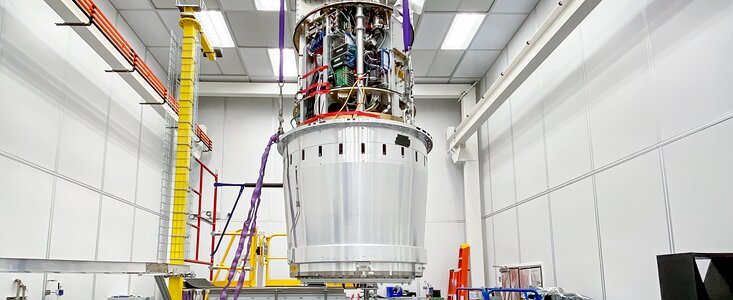Consiguen exitoso enfriamiento de la cámara de Rubin
La Cámara LSST del Observatorio Vera C. Rubin se enfrió a temperaturas bajo cero mediante el uso simultáneo de los dos sistemas de refrigeración de la cámara
19 Noviembre 2021
El equipo del Laboratorio Nacional del Acelerador SLAC que desarrolla la Cámara de la Investigación del “Espacio-Tiempo” como legado para la posteridad para el proyecto del Observatorio Vera C. Rubin (LSST, por sus siglas en inglés), celebró un día muy frío durante la última semana de octubre, pero no por el clima, sino porque los dos sistemas que mantienen enfriada la Cámara LSST, funcionaron sin inconvenientes por primera vez desde enero de 2021.
La Cámara de LSST genera mucho calor debido a su tamaño, produciendo cerca de 10 veces más calor que las primeras cámaras astronómicas. Por tal motivo, el sistema de refrigeración es necesario para mantener los sensores del plano focal a una temperatura de operación óptima y eliminar el calor generado por la electrónica asociada, sin introducir vibraciones que puedan afectar la calidad de imagen. El equipo de la cámara desarrolló dos sistemas por separado con el objetivo de alcanzar esta meta. Se trata del sistema “Cold”, que enfría los dispositivos electrónicos, y el sistema “Cryo”, que enfría los dispositivos de carga acoplada (CCDs) de la cámara.
Los sistemas Cold y Cryo estaban operando juntos a principios de 2021, pero en ese momento, el sistema Cryo operaba con intercambiadores de calor temporales (integración y prueba), y el “utility trunk” (que alberga el soporte electrónico de la cámara y las utilidades) no estaba aún conectado al criostato (que contiene el plano focal y su electrónica). También hubo algunos problemas de rendimiento con el sistema Cold que necesitaban solución. Todo este trabajo ocurrió en los meses intermedios y, en septiembre, el equipo de cámaras estaba listo para iniciar el proceso de varios pasos necesarios para que ambos sistemas vuelvan a funcionar.
El sistema Cold fue el primero en ponerse en marcha, el 27 de septiembre de 2021, y pronto enfrió los dispositivos electrónicos a un rango entre –10 °C y +10 °C (14 °F y 50 °F). Las mejoras realizadas por el equipo resolvieron los problemas de rendimiento anteriores, y el sistema estaba funcionando sin problemas.
Luego, se iniciaron los preparativos para la puesta en marcha del sistema Cryo, lo que involucró una serie de pasos cuidadosos y específicos, especialmente porque era la primera vez que el sistema funcionaba con los intercambiadores de producción de calor. Cada uno de los seis circuitos del sistema Cryo fueron encendidos deliberadamente, luego se apagaron, y después se volvieron a encender, Con eso, el sistema comenzó a enfriar los CCDs, alcanzando finalmente una temperatura muy baja de –100 °C (–148 °F). Ambos sistemas demoran entre 12 a 18 horas en alcanzar sus temperaturas de enfriamiento finales.
Ahora que los dos sistemas están funcionando exitosamente, el equipo de la cámara comenzará una serie completa de pruebas electro-ópticas para optimizar el rendimiento del plano focal (que incluye los CCDs, dispositivos electrónicos y los sistemas termales). A esto le seguirá un completo set de verificación en condiciones de operación prácticamente definidas. Estas pruebas implicarán recopilar aproximadamente seis semanas de datos (en forma de una infinidad de imágenes), y probar una variedad de factores como la difusión, ruido de lectura, píxeles o columnas oscuras o calientes, ganancia, cross-talk, non-linearity, efecto brighter-fatter, e ineficiencia en la transferencia de carga. Se podría decir que la cámara LSST está cada vez más cerca de estar lista para enviarse a Chile en el 2022.
Más información
El Observatorio Rubin es una iniciativa conjunta de la Fundación Nacional de Ciencia de los Estados Unidos (NSF) y el Departamento de Energía de Estados Unidos (DOE). Su misión principal es llevar a cabo la Investigación del “Espacio-Tiempo” como legado para la posteridad, proporcionando un conjunto de datos sin precedentes para la investigación científica respaldada por ambas agencias. Rubin es operado conjuntamente por NOIRLab de NSF y el Laboratorio Nacional del Acelerador SLAC. NOIRLab es administrado para NSF por la Asociación de Universidades para la Investigación en Astronomía (AURA) y SLAC es operado para DOE por la Universidad de Stanford.
NOIRLab de NSF (Laboratorio Nacional de Investigación para la Astronomía Óptica-Infrarroja de NSF), el centro de EE.UU para la astronomía óptica-infrarroja terrestre, opera el Observatorio internacional Gemini (una instalación de NSF, NRC–Canada, ANID–Chile, MCTIC–Brasil, MINCyT–Argentina y KASI – República de Corea), el Observatorio Nacional Kitt Peak (KPNO), el Observatorio Interamericano Cerro Tololo (CTIO), el Centro de Datos para la Comunidad Científica (CSDC) y el Observatorio Vera C. Rubin. Está administrado por la Asociación de Universidades para la Investigación en Astronomía (AURA) en virtud de un acuerdo de cooperación con NSF y tiene su sede en Tucson, Arizona. La comunidad astronómica tiene el honor de tener la oportunidad de realizar investigaciones astronómicas en Iolkam Du’ag (Kitt Peak) en Arizona, en Maunakea, en Hawai‘i, y en Cerro Tololo y Cerro Pachón, en Chile. Reconocemos y apreciamos el importante rol cultural y la veneración que estos sitios tienen para la Nación Tohono O’odham, para la comunidad nativa de Hawai‘i y para las comunidades locales en Chile, respectivamente.
Enlaces
- Sitio web del Observatorio Vera C. Rubin
- Fotos del Observatorio Vera C. Rubin
- Videos del Observatorio Vera C. Rubin
- Sitio web del Laboratorio Nacional del Acelerador SLAC
Contactos
Vanessa Thomas
Public Information Officer
NSF’s NOIRLab
Tel: +1 520 318 8132
Email: vanessa.thomas@noirlab.edu


